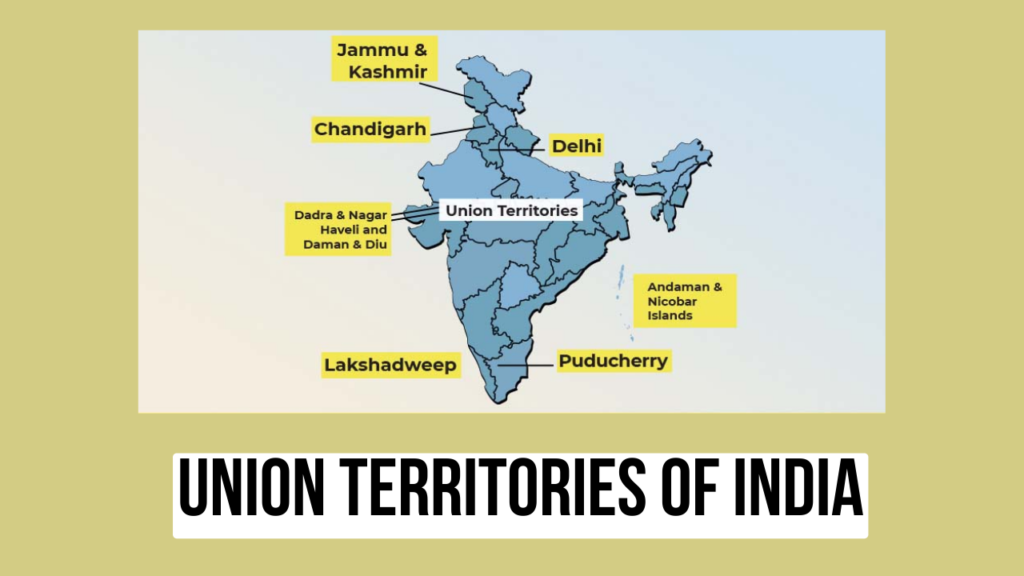India, a country known for its diverse culture and rich history, consists of several administrative divisions. Among these are the Union Territories of India. Currently, there are eight union territories. This number changed recently when the state of Jammu and Kashmir lost its statehood and was reorganized. On 31 October 2019, Jammu and Kashmir became a separate union territory, while Ladakh was established as another union territory. Additionally, on 26 January 2020, the union territories of Dadra and Nagar Haveli and Daman and Diu were merged, resulting in the current eight union territories. Let’s explore each of these union territories in detail.
List of Union Territories of India
Here is a list of the Union Territories of India along with their capitals and dates of creation:
| Union Territory | Capital | Date of Creation |
|---|---|---|
| Andaman and Nicobar Islands | Port Blair | 1 November 1956 |
| Chandigarh | Chandigarh | 1 November 1966 |
| Dadra and Nagar Haveli and Daman and Diu | Daman | 26 January 2020 |
| Delhi | New Delhi | 1 November 1956 |
| Lakshadweep | Kavaratti | 1 November 1956 |
| Puducherry | Pondicherry | 1 November 1954 |
| Jammu and Kashmir | Srinagar (Summer), Jammu (Winter) | 31 October 2019 |
| Ladakh | Leh | 31 October 2019 |
Exploring the Union Territories

1. Andaman and Nicobar Islands
Located in the Bay of Bengal, the Andaman and Nicobar Islands stretch from the southern border of Myanmar to the northern border of Indonesia. Port Blair is the capital, serving as the administrative headquarters. With an area of approximately 8,249 square kilometers, it is one of India’s largest union territories. The population is around 400,000 people, including diverse tribes and natural tribes. Major languages spoken are Hindi, Nicobarese, Bengali, Tamil, Malayalam, and Telugu. The Andaman and Nicobar Islands are also known for their natural beauty, beaches, forests, religious places, and marine life, making them a significant tourist destination.
2. Dadra and Nagar Haveli and Daman and Diu
The union territories of Dadra and Nagar Haveli and Daman and Diu were merged to form a single union territory. Historically, this region played a crucial role from 1954 to 1961, known then as the “Free Dadra and Nagar Haveli Administration.” This union territory is administered by administrators appointed by the Central Government. Silvassa is the capital of Dadra and Nagar Haveli, while Daman serves as the capital of Daman and Diu. Gujarati and Hindi are the main languages. The local culture, festivals, and traditions reflect an updated version of Indian culture. The economy is driven by industry, tourism, the paper industry, and the plastic industry.
3. Lakshadweep
Located in the Arabian Sea, Lakshadweep is an archipelago consisting of 36 islands, with only 11 inhabited. Kavaratti is the capital, and Malayalam is the main language. Other languages spoken include Jeseri and Mahal. The area is about 32 square kilometers, and the population is around 64,429. The primary economic activities are shipbuilding, fishing, tourism, and palm production. Lakshadweep is known for its natural beauty, marine life, and clean, beautiful beaches.
4. Puducherry
Puducherry is an important tourist destination with its capital also named Puducherry. The region is known for its culture, diversity, and historical significance. The area is 479 square kilometers, with a population of approximately 1,244,464. Languages spoken include Tamil, Telugu, Malayalam, English, and French. Puducherry’s cultural heritage reflects the influence of French and Tamil cultures, and it has a rich history, having been under French sovereignty. The French architectural influence is still visible today.
5. Delhi
Delhi, the capital of India, is located in the Indian subcontinent. It is a major city with the highest population among the union territories. The area is 1,483 square kilometers, and the population is around 16,753,235. Delhi is a significant center for Indian culture and history, known for its administrative structures, historical monuments, temples, mosques, and government buildings. The main languages are Hindi, Punjabi, Urdu, and English. Delhi is a melting pot of multilingual and multi-ethnic residents and serves as an important event and commercial center.
6. Chandigarh
Chandigarh is both a union territory and the joint capital of Haryana and Punjab. The official language is English, but Hindi and Punjabi are widely spoken. Known as “Pensioner’s Paradise,” Chandigarh is home to many famous schools and higher educational institutions. It is famous for its urban design and architecture, being one of the earliest planned cities in post-independent India, designed by Swiss-French architect Le Corbusier. In 2016, the capitol complex in Chandigarh was declared a World Heritage Site by UNESCO.
7. Jammu and Kashmir
On 31 October 2019, Jammu and Kashmir were reorganized from state status to a union territory. Ladakh was separated and made a separate union territory. The winter capital of Jammu and Kashmir is Jammu, while the summer capital is Srinagar. The literacy rate is 67.16%, and major languages are Hindi, English, Dogri, and Kashmiri. The economy primarily relies on agriculture, with major exports including apples, pears, cherries, plums, saffron, and walnuts. Kishtwar is known as the ‘land of sapphire and saffron.’
8. Ladakh
Leh is the capital city of Ladakh, with Kargil being the second-largest town. Famous for the Indus, Nubra, and Shyok river valleys, Ladakh became a separate union territory after the 2019 reorganization act. The population is predominantly Muslim (46%), followed by Buddhists (40%) and Hindus (12%). Ladakh is bordered by Jammu and Kashmir, Himachal Pradesh, and the Tibet Autonomous Region.